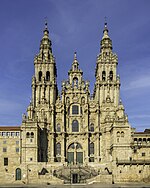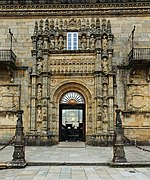Monastery of San Martiño Pinario
Baroque architecture in Galicia (Spain)Benedictine monasteries in SpainBuildings and structures completed in 1102Buildings and structures in Santiago de CompostelaChristian monasteries established in the 9th century ... and 3 more
Monasteries in Galicia (Spain)Religious buildings and structures completed in 1652Seminaries and theological colleges in Spain

The monastery of San Martiño Pinario (San Martín Pinario in Castilian) was a Benedictine monastery in the city of Santiago de Compostela, Galicia, Spain. It is the second largest monastery in Spain after San Lorenzo de El Escorial. Little remains of the original medieval buildings, as the monastery has been largely rebuilt since the sixteenth century. The monastery was closed in the nineteenth century in the Ecclesiastical Confiscations of Mendizábal. The buildings currently house a seminary.
Excerpt from the Wikipedia article Monastery of San Martiño Pinario (License: CC BY-SA 3.0, Authors, Images).Monastery of San Martiño Pinario
Rúa da Conga, Santiago de Compostela O Ensanche
Geographical coordinates (GPS) Address Nearby Places Show on map
Geographical coordinates (GPS)
| Latitude | Longitude |
|---|---|
| N 42.881944444444 ° | E -8.5444444444444 ° |
Address
Cidade Vella
Rúa da Conga
15704 Santiago de Compostela, O Ensanche
Galicia, Spain
Open on Google Maps









